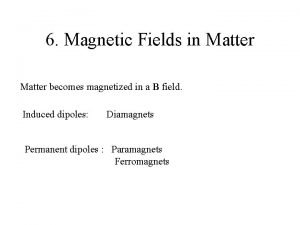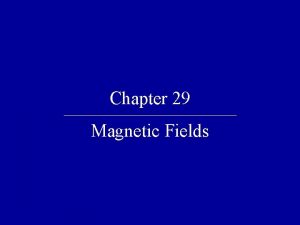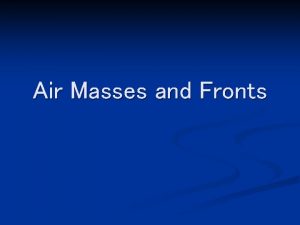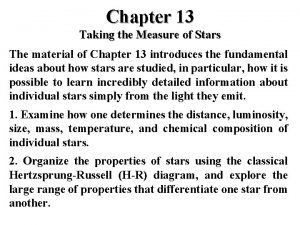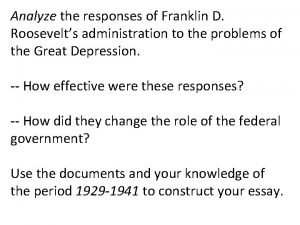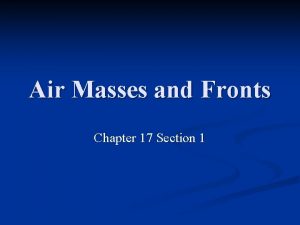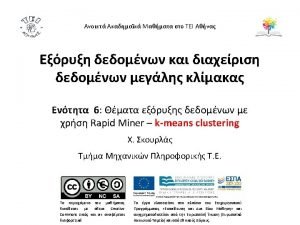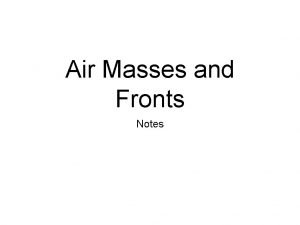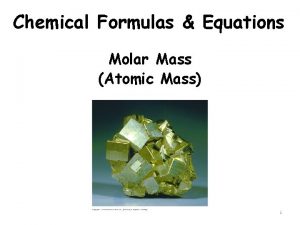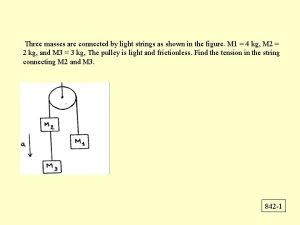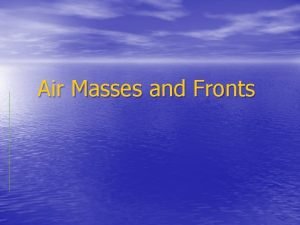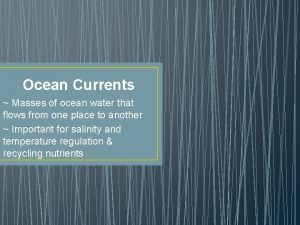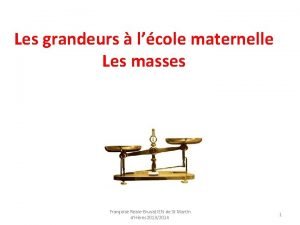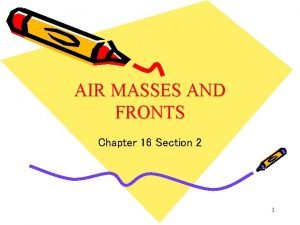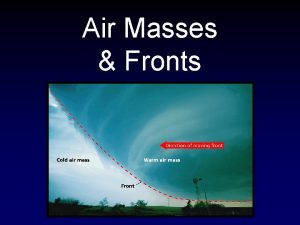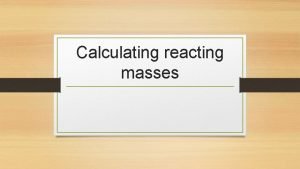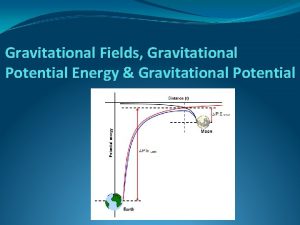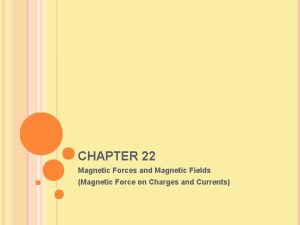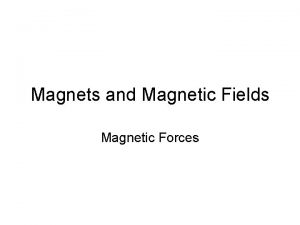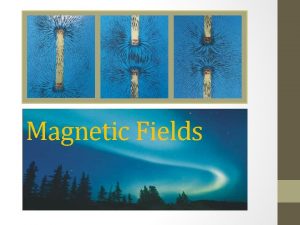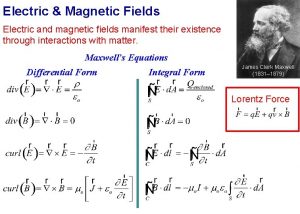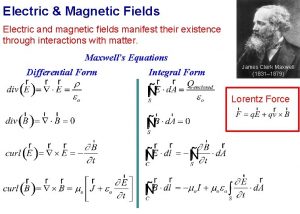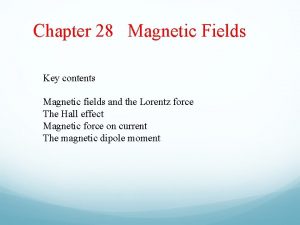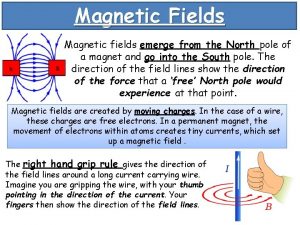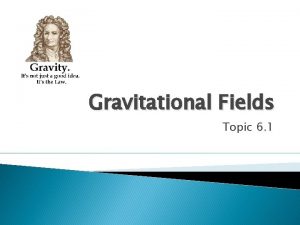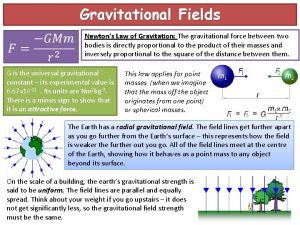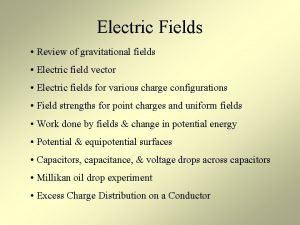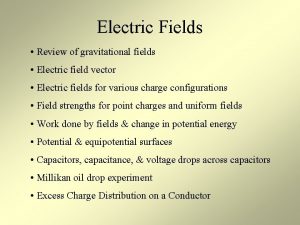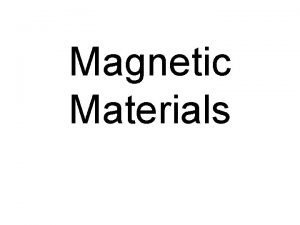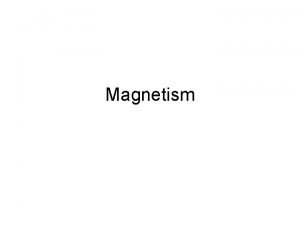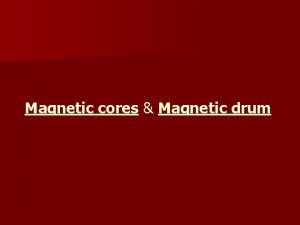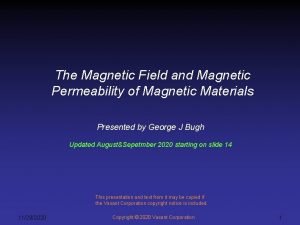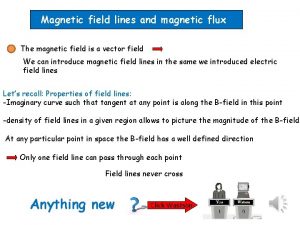Creating magnetic fields Gravitational fields act on masses










![Calculating Magnetic Fields B = (mo I /4 p) [sin(q. Ir) / r 2] Calculating Magnetic Fields B = (mo I /4 p) [sin(q. Ir) / r 2]](https://slidetodoc.com/presentation_image/d0ea993f680edb83b9d7dfde5fd24048/image-11.jpg)






![Field off-axis B = (mo I /4 p) [sin(q. Ir) / r 2] d. Field off-axis B = (mo I /4 p) [sin(q. Ir) / r 2] d.](https://slidetodoc.com/presentation_image/d0ea993f680edb83b9d7dfde5fd24048/image-18.jpg)































- Slides: 49

Creating magnetic fields Gravitational fields act on masses, and masses set up gravitational fields: Fgravity = mg where g = GM/r 2 Electric fields act on charges, and charges set up electric fields: Felectric = q. E where E = k. Q/r 2 Magnetic fields act on moving charges; do moving charges set up magnetic fields?

Creating Magnetic Fields Magnetic fields act on moving charges; do moving charges set up magnetic fields? YES! From the gravitational and electric cases, we can guess that we will need: a constant that describes the strength similar to G and k; an inverse square relationship with distance (1/r 2) because of the 3 -D nature of space; and a dependence on what is acted upon (like m and q) - in this case moving charges, qv.

Creating Magnetic Fields But we also have the right hand rule in the magnetic force equation, and we’ll need a right hand rule in the field-generating equation also.

Magnetic Fields Moving charges do create magnetic fields: B = (mo/4 p) q v sin(qvr) / r 2 direction: right hand rule thumb = hand fingers This law is called the Biot-Savart Law Point your right hand in the direction of v, curl you fingers in the direction of r where r is the distance from the moving charge that creates the field to the location in space where the field is, and the field, B, will be in the direction of your thumb; if the charge is negative, the field direction is opposite that of your thumb or use your left hand.

Right hand rule The r is the distance from the moving charge to the location in space where the created field is. B 2 B 1 r 2 qv r 3 B 3

Magnetic Constant The constant (mo/4 p) is a seemingly strange way of writing a constant that serves the same purpose as G and k, but that is exactly what it does. The value: (mo/4 p) = 1 x 10 -7 T*m*sec/Coul (or 1 x 10 -7 T*m/Amp). In fact, the constant k is sometimes written as: k = 1/(4 peo). [In both cases, the sub zero on m and e indicates the field is in vacuum. ]

4 p ? Why does the combination of 4 p enter into the constant? Consider the field idea where the mass, charge, or in this case the moving charge, sets up the field by throwing out field particles. The density of these field particles, and hence the strength of the field, depends on the number of field particles (a constant) and the area they are going through. This area is that of a sphere: 4 pr 2. Thus the 4 p really goes with the r 2 in the denominator: B = mo q v sin(qvr) / (4 p r 2)

Creating Magnetic Fields A single moving charge does create a magnetic field in the space around it, but since both the charge (q = 1. 6 x 10 -19 C) and the constant (mo/4 p = 1 x 10 -7 T*m/Amp) are very small, we usually don’t have to worry about these effects for a single electron or ion. But if we have a series of charges moving (which means a current), then we can generate an appreciable magnetic field.

Currents and Magnetic Fields A moving charge (qv) actually can be thought of as a current over a small length like we did with the electric motor: qv = q(DL/Dt) = (DQ/Dt)DL = I DL , so that we have for each small length: B = (mo/4 p) I DL sin(q. Ir) / r 2 with direction: thumb(field) = hand(current) fingers(radius).

General Case For the current over a complete circuit, the field produced at any particular point in space will depend on where the point is and the shape of the circuit. B = (mo I /4 p) [sin(q. Ir) / r 2] d. L where both q. Ir and r depend on d. L (that is, they depend on which d. L we are at in the sum). Keep in mind that the magnetic field is a vector, so we need to use the RHR and consider components!
![Calculating Magnetic Fields B mo I 4 p sinq Ir r 2 Calculating Magnetic Fields B = (mo I /4 p) [sin(q. Ir) / r 2]](https://slidetodoc.com/presentation_image/d0ea993f680edb83b9d7dfde5fd24048/image-11.jpg)
Calculating Magnetic Fields B = (mo I /4 p) [sin(q. Ir) / r 2] d. L Note that the formula for B has the mo and I in the numerator, and it has units of distance in the denominator. This should happen for all Magnetic Field equations due to a current. The integral, [sin(q. Ir) / r 2] d. L , may be difficult since both q. Ir and r depend on the d. L, and we have to worry about the direction for the vector, B; but if we have some symmetry we may be able to get a nice analytical equation. We’ll look at several cases now.

Field at the Center of a Loop B = (mo I /4 p) [sin(q. Ir) / r 2] d. L At the center of a circle of current, r = R = constant, and q. IL = 90 o = constant. Note: all elements will give a field out of the loop! Thus the integral is trivial and we have: Bat center of circle = (mo I /4 p)* [(1) / R 2] (2 p. R) = mo I / 2 R. If we have several turns in the wire, each B R I turn contributes: B = mo. NI / 2 R.

Field at the Center of a Loop B = mo. NI / 2 R Note that this field depends on the current (both N and I) and the shape (R). [Note that the only parameter associated with a circle is R. ] It has the magnetic constant (mo) in it as well. Only the 2 in the formula can’t be immediately guessed at. Note also that it has the mo and I in the numerator, and it has a distance in the denominator. This should happen for all the different geometries.

Example What is the field strength at the center of a loop that has 5 Amps running through 300 turns, where the radius of the loop is 6 cm? Bat center of loop = mo N I / 2 R B = (4 p x 10 -7 T*m/A) * 300 * 5 A / (2*. 06 m) =. 0157 T = 157 Gauss.

Field on axis of circular loop What is the magnetic field on axis but not at the center of a circular loop of current? Using the RHR, the magnetic field due to the element on the right (current going into the page) is up and right as shown on the diagram. B The horizontal field will cancel a r in pairs, but the vertical R components will add! I

Field on axis of circular loop By = B cos(q. B) where the red dot indicates the angle q. B on the diagram. Again from the diagram we can see that cos (q. B) = R/r. Note that q. B is a different angle than q. Ir. From B = (mo I /4 p) [sin(q. Ir) / r 2] d. L with r = constant and q. Ir= 90 o B we have with cos (q. B) = R/r : By = {(mo I /4 p)*[(1)/r 2]*2 p. R}*cos(q. B) a r = mo I R 2 / 2 r 3 R where r = [a 2 + R 2]1/2. I

Field on axis of circular loop Bon axis = mo I R 2 / 2 r 3 Note here also that there is a mo and I in the numerator, and an inverse distance. The geometry depends on both R and r, and both parameters are included in the formula. Note that as a becomes small, r approaches R, and B approaches the result we had for the field at the center of the coil: Bloop = mo I / 2 R.
![Field offaxis B mo I 4 p sinq Ir r 2 d Field off-axis B = (mo I /4 p) [sin(q. Ir) / r 2] d.](https://slidetodoc.com/presentation_image/d0ea993f680edb83b9d7dfde5fd24048/image-18.jpg)
Field off-axis B = (mo I /4 p) [sin(q. Ir) / r 2] d. L Note that if we try to find the field off-axis, both q. Ir and r no longer remain constant, and hence the integral becomes very hard to integrate!

Magnetic Field due to a current in a straight wire Let’s now consider the magnetic field at some point ( ) a distance, a, above a current, I, in a straight wire. We start with the Biot-Savart Law: B = (mo I /4 p) [sin(q. Ir) / r 2] d. L. By the RHR: hand (I) →, bend fingers (r) ↑, thumb (B) , the direction of B is out of the screen, , above the wire and into the screen below the wire. B r a I B

Magnetic Field due to a current in a straight wire B = (mo I /4 p) [sin(q. Ir) / r 2] d. L From the diagram, we see that is the angle q. Ir and so sin(q. Ir) = a/r. We see that both q. Ir and r depend on which d. L we are at. Thus the integral is not trivial, but it does look like one we have done before! B r a -x I

Magnetic Field due to a current in a straight wire B = (mo I /4 p) [sin(q. Ir) / r 2] d. L. B = (mo I /4 p) x. L x. R [(a/r) / r 2 ] dx where r = [x 2 + a 2]1/2. Using the same trick we did before for this integral (method of substitution), we B get: r a -x I

Magnetic Field due to a current in a finite straight wire Bshort wire = (mo I /4 pa)*[cos(q. L) - cos(q. R)]. Where q. L is the angle and q. R is the angle which is greater than 90 o so cos(q. R) < 0 in this case. B a I If the field point is in front of the wire, both angles will be < 90 o and if the field points is behind the wire, both angles will be > 90 o.

Magnetic Field due to a current in a straight wire Bshort wire = (mo I /4 pa)*[cos(q. L) - cos(q. R)]. For a long wire (a « -x. L so q. L→ 0 o and a « x. R so q. R→ 180 o) this reduces to: Blong wire = (mo I /2 pa). From the cylindrical symmetry of the wire, we see that the magnetic field is directed around the wire. Note that we again have mo and I in the numerator, and an inverse distance (1/a).

Magnetic Field due to a current in a straight wire Bshort wire = (mo I /4 pa)*[cos(q. L) - cos(q. R)]. Blong wire = (mo I /2 pa). For a short wire, both the length and distance to the wire are contained in the angles q. L and q. R. For a long wire, the only geometric parameter is a, the distance the point is from the wire. For comparison, recall that at the center of a circular loop, B = (mo I /2 a) (no π in the denominator).

Shortcut RHR rule #1 For the case of a circular loop of wire, the magnetic field went straight through the center. If you curl your right hand fingers in the direction of the current around the loop, your thumb points in the direction of the field through the center of the loop.

Shortcut RHR rule #2 For the case of the straight wire, if you point your right hand thumb in the direction of the straight current, your fingers will curl around in the direction of the circular magnetic field around the wire. Warning: make sure you use your right hand when doing these RHR shortcuts!

Computer Homework There is a computer homework assignment, Vol. 4, #3, on Magnetic Fields that will give you practice with calculating the magnetic fields due to different current geometries.

The Solenoid The solenoid is an important special case for creating magnetic fields. A solenoid is a coil of wire that is wrapped around a cylinder rather than around a circle. It has elements of both the circular loop and the straight wire. It can be solved the straight-forward way, but there is an easier (but trickier) way - we’ll talk about this easier way next.

Gauss’ Law for Magnetism Recall from Part I, Gauss’ Law for Electricity: closed area E d. A = 4 pk. Qenclosed. This looked like a hard way to solve for E (since E is inside the integral), but using symmetry it sometimes turns out easy. For magnetism, we cannot separate poles, therefore we cannot enclose any poles. This means that we have: closed area B d. A = 0. Since this integral equals zero, it looks like it might not be that useful, but it and Gauss’ Law for Electric Fields both turn out to be very important and two of the 4 major E&M equations.

Another Law Recall from Part I that Electric Fields started on positive charges and went towards negative charges. For magnetic fields, however, the magnetic fields circle around currents. This leads to: closed loop B d. L = (constant) * Iencircled. Again, this looks like it will be hard to solve for B (since B is inside the integral), but we’ll see that for some symmetric results, it turns out to be simple.

Ampere’s Law closed loop B d. L = (constant) * Iencircled. To determine the constant, we use something we already know: the field due to a long straight wire: B = mo. I/2 pa. If we choose a circular loop with radius, a, around the wire, the B field is constant around the loop and always in the direction of the loop and so the B and the dot can come out of the integral. This leaves us with: (mo. I/2 pa) * 2 pa = constant * I. Thus the constant is simply mo. Thus Ampere’s Law is: closed loop B d. L = mo Iencircled. This also turns out to be the 3 rd of the 4 major E&M equations. We’ll get the fourth law in Part 4 when we deal with electromagnetism.

Back to the solenoid closed loop B d. L = mo Iencircled. In using Ampere’s Law, we need to specify a particular closed loop (just as we needed to specify a particular closed area in using Gauss’ Law for Electric Fields). I coming out of page Let’s first consider generally how the field should look: I going into page

The Solenoid Inside the solenoid, the field should be in the same direction as for a circular coil: bend your fingers around in the direction of the circular current, and your thumb will point in the direction of the field: hand bend fingers ↓ Binside thumb points → hand bend fingers thumb points → Also use shortcut rule #1: circular current (bend fingers) gives straight field (thumb).

Inside the Solenoid If we choose a Binside rectangular loop inside the solenoid and go around this loop in a clockwise sense, then Ampere’s Law closed loop B d. L = mo Iencircled indicates that, since no current is encircled by our rectangle (Iencircled = 0), and since the up and down lengths are to the field, the field near the top and the field in the middle must be the same!

Outside the solenoid This means that the field inside the solenoid is constant (just like the Electric Field was constant between parallel plates). The constant electric field between parallel plates was important in getting capacitance, and in a similar way in Part 4 this constant magnetic field in a solenoid will be important in getting inductance. The same argument applies for outside the solenoid, and since we know the field very far away from the long solenoid should be zero, the field near the solenoid (but outside of it) should also be near zero (again like the E field outside of the parallel plates).

Value of Field Inside Boutside = 0 To find the field inside Binside we choose a rectangular loop half outside and half inside. Since the field is to the field on the up and down sides, and since the field is zero on the top, we have: Binside L = mo N I where N is the number of loops in the rectangle of length L.

B inside solenoid closed loop B d. L = mo Iencircled becomes Binside L = mo N I , and when we move the L over to the right side and define n = N/L: Binside-long = mo n I. This holds very well for a very long solenoid. If we do this exactly for a shorter solenoid we get: Binside-short = ½mo n I [cos(q. R) - cos(q. L)]. As the diameter of the solenoid becomes small compared to its length, q. R 0 o and q. L 180 o giving the long result (see next slide for diagram showing angles).

Solenoid a = R = ½Diameter x. R where x. R-x. L= L = q. R a = R = ½Diameter -x. L where x. R-x. L= L = q. L [Note: For this position, x. L < 0 and so cos(θL) < 0. ]

Solenoid Binside-long = mo n I Binside-short = ½mo n I [cos(q. R) - cos(q. L)] Note that in both cases, we have mo and I in the numerator. But where is the inverse distance?

Solenoid Binside-long = mo n I Binside-short = ½mo n I [cos(q. R) - cos(q. L)] Note that in both cases, we have mo and I in the numerator. But where is the inverse distance? It is inside the n (n = N/L)! Note that the radius for a long solenoid doesn’t matter. For a short solenoid, the radius and length are both involved in the angles q. R and q. L.

Force between Currents Masses create gravitational fields that act on other masses, so masses act on other masses. Charges create electric fields that act on other charges, so charges act on other charges. How about currents? Does the mass in one wire affect another wire? Does the charge in one wire affect another wire? Does the current in one wire affect another wire?

Forces between wires Does the mass in one wire affect another wire? Yes, but the amount is insignificant. Does the charge in one wire affect another wire? Normally wires are not charged, so they normally do not affect another wire via this way. Even when they carry current, the current leaving the wire equals the current entering the wire. This normally leaves the wire uncharged even when current is flowing through it!

Forces between currents The current in one wire does set up a magnetic field in the area around the wire, and this magnetic field will act on another current in a neighboring wire and possibly exert a force. Generally, though, this is a small force and a very hard calculation, since the magnetic field will vary across the other wire.

Example here is a case we can work out I 1 = 0. 5 Amps What is the force on the I 2 = 15 Amps rectangular circuit due to the presence of the 8 cm current in the long wire, direction & magnitude? 4 cm 7 cm

Example B 1 is the field due to I 1 = 0. 5 Amps By symmetry, the force I 2 = 15 Amps on the top and bottom B 1 Ftop parts cancel. 8 cm Since the left side is Fbottom closer than the right, the 4 cm force on the left side will 7 cm “win”.

Example I 1 = 0. 5 Amps I 2 = 15 Amps B 1 Fleft 8 cm By the RHR, the B 1 field due to the long wire at the left side wire is into the screen. The force on the left side by the RHR is then to the right (repulsive).

Example I 1 = 0. 5 Amps I 2 = 15 Amps Bleft = mo. I 1 / 2 p (. 04 m) = (2 x 10 -7 T*m/A)(0. 5 A)/(. 04 m) = 2. 5 x 10 -6 T B 1 8 cm Fleft = I 2 L Bleft Fright = (15 A)(. 08 m)(2. 5 x 10 -6 T) 4 cm = 3. 0 x 10 -6 Nt to the right 7 cm Similarly, with a weaker B, Fright = 1. 71 x 10 -6 Nt to the left Units: Recall from F=qv. B that T = Nt*s/A*m

Example I 1 = 0. 5 Amps I 2 = 15 Amps B 1 Fleft 4 cm 7 cm FL = 3. 0 x 10 -6 Nt to the right FR = 1. 7 x 10 -6 Nt to the left 8 cm FT = 1. 3 x 10 -6 Nt to the right Fright Note that parallel currents attract, and antiparallel currents repel.

Review Basic Magnetic Force Law (Lorentz Force): F = q v B sin(qv. B) or F = qv B Creating Magnetic Fields (Biot-Savart Law): B = (mo/4 p) q v sin(qvr) / r 2 or B = (mo/4 p) q v r/r 3 Gauss’ Law for Magnetism: closed area B d. A = 0 Ampere’s Law: closed loop B d. L = mo Iencircled The dot product ( ) of two vectors is a scalar that involves the magnitudes of the two vectors times the cosine of the angle between them. The cross product ( ) of two vectors is a vector that involves the magnitudes of the two vectors times the sine of the angle between them, and the direction of the resulting vector is perpendicular to both of the other vectors and directed using the right hand rule.
 Red fields
Red fields Scrap heap magnet circuit diagram
Scrap heap magnet circuit diagram Electric currents and magnetic fields
Electric currents and magnetic fields Magnetic fields in matter
Magnetic fields in matter Magnetic fields quick
Magnetic fields quick Learning: module 26: magnetic forces and fields
Learning: module 26: magnetic forces and fields Electric currents and magnetic fields
Electric currents and magnetic fields Force on charged particle
Force on charged particle Magnetic permeability of materials
Magnetic permeability of materials Flux formula
Flux formula Magnetic moment and magnetic field relation
Magnetic moment and magnetic field relation Macbeth act 2 summary
Macbeth act 2 summary U in electricity
U in electricity Air masses & frontswhat is an air mass?
Air masses & frontswhat is an air mass? Two cold air masses converge on a warm air mass
Two cold air masses converge on a warm air mass Empowering the masses
Empowering the masses Astronomers measure the masses of stars by
Astronomers measure the masses of stars by Jet stream map
Jet stream map Two astronauts of masses 60 kg and 80 kg
Two astronauts of masses 60 kg and 80 kg Air masses
Air masses Letter to senator robert wagner 1934
Letter to senator robert wagner 1934 Air masses form in the tropics and have low pressure
Air masses form in the tropics and have low pressure Mnorthdata
Mnorthdata Air masses and fronts
Air masses and fronts Four oval masses on posterior thyroid gland
Four oval masses on posterior thyroid gland Low pressure air mass
Low pressure air mass Periodic table with molar masses
Periodic table with molar masses Stellar graveyard
Stellar graveyard Air mass vocabulary
Air mass vocabulary Three masses are connected by strings
Three masses are connected by strings What are middle-latitude cyclones?
What are middle-latitude cyclones? Stationary front
Stationary front Masses of ocean water that flow from one place to another
Masses of ocean water that flow from one place to another Defintion mass
Defintion mass Lake effect side
Lake effect side Draw the symbol for a cold front
Draw the symbol for a cold front Les masses gs
Les masses gs Air masses
Air masses What happens when 2 air masses meet
What happens when 2 air masses meet Data mining for the masses
Data mining for the masses Air masses and their characteristics
Air masses and their characteristics Tropical air mass
Tropical air mass Front
Front Importance of air masses
Importance of air masses Masses of cells form and steal nutrients from healthy cells
Masses of cells form and steal nutrients from healthy cells Meteorological symbols for four types of fronts
Meteorological symbols for four types of fronts Whats an air mass
Whats an air mass Zinc carbonate
Zinc carbonate Air mass modification
Air mass modification Are huge circular moving current systems
Are huge circular moving current systems



